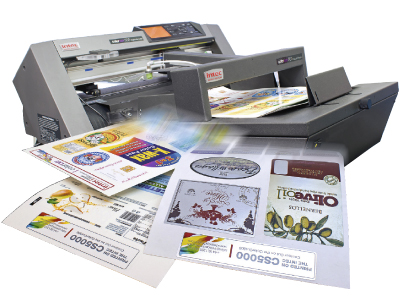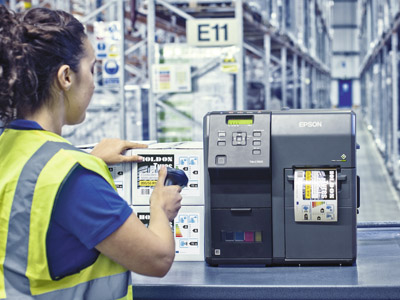Epson ColorWorks C7500 series works well in a production environment
A relatively low investment can get you into the digital label printing game. Desktop label printers and small production systems offer high productivity and on demand delivery for printers and in-house facilities alike. By Neel Madsen.
The ability to bring label printing in house appeals to a wide range of manufacturing companies in sectors across the board from small to medium food producers to chemical companies, and for commercial printers, a smaller system is a great way to dip their toe in the lucrative packaging market.
Nathan Daniel, Afinia Label’s EMEA sales manager, explains why he believes his company has seen a growth in demand for small digital label finishers, ‘Bringing your label printing and finishing in-house enables a lot of freedom. You aren’t restricted to minimum or maximum pre-cut label sizes, standard label shapes, or waiting for your label delivery. It’s digital and on-demand, giving companies control of their own label production, all while saving money.’
White is good
Poole-based Intec Printing Solutions was established in 1989. It sells the LP215, a GHS classified dry toner LED label printer that prints onto pre die-cut media or rolls of substrates. One of the main selling points is the ability to print white toner.
‘Commercial printers and private brand owners have had a whole new range of market opportunities opened up to them with the introduction of UV white toner for the Intec LP215. The opaque white toner can be under-printed or used as spot elements to enhance designs for printing on dark or coloured substrates, transparent and clear films,’ said Terri Winstanley, product and marketing manager.
The label printer can be combined with the LCF215 for finishing and the Intec RIP pod with PC workstation and software to offer a full label production system. The finisher is a compact unit that offers lamination, contour cutting, matrix removal and slitting of printed roll labels. Working like a plotter-cutter with a digitally controlled knife made from steel, it can select one to three registration points using the SMARTMark Optical Registration System. Ms Winstanley commented, ‘The essence of the LCF215 is that it can compensate for any skew, scale or print position of labels that have been printed through a digital device.’

Intec’s ColorCut 500 for sheet label cutting
Intec also offers the new ColorCut 500 for sheet label cutting, which was first introduced late last year. It cuts sheets of labels produced on any digital colour printer at a speed of 30 to 40 seconds for an SRA3 size and features camera-based Vision Registration, which will adjust the sheets to compensate for errors made during the printing process.
Going nuclear
Label and packaging printer manufacturer New Solution is headquartered in Portugal where it has set up a manufacturing facility supported by EU funding. All components and software are developed and produced in house by an experienced engineering team.
The company recently added the NS Atom compact label printer to its portfolio. The machine is aimed at in-house label printing for small businesses, brands, manufacturers and retail outlets. The new desktop label printer features a single pass, Sirius memjet printhead, which prints CMYKK at speeds up to 18 m/min in a maximum resolution of 1600 x 1600dpi. It has been configured with a light sensor for reading pre-die cut label rolls in widths from 80 to 240mm, but can also print sheets of labels.
In addition to the NS Atom, New Solution has also brought the NS Multi Printer, the NS Pro Printer and the NS F22 Finisher to market in the last year. These were all launched at drupa 2016.
Last October, the printers were introduced to the UK at an open house. At the same time, KTEC Group was appointed UK master dealer of the NS range, when a deal was done with the New Solution UK. Founded by managing director Robert Knox, KTEC has specialised in the distribution of desktop roll fed label printers, accessories and consumables for
over 30 years.
Mr Knox commented, ‘Our markets have widened with the growth in demand for in-house printing of short run labels, own branding and personalisation, and we’ve seen our business grow exponentially. The NS range fits at the very top of our portfolio and into our AnyLabel (any size + any shape + any quantity) label making equipment programme.’ He continued, ‘Our manufacturing customers will enjoy the ability to reduce label inventory to a few rolls of plain label media whilst creating labels quickly for a variety of outgoing goods. Our commercial label print houses will be able to add a digital label roll print capability at an affordable cost.’
Durability
Primera Technology has just added the LX1000e Color Label Printer to its wide portfolio of desktop machines. It is an entry-level unit based on the company’s existing LX2000e model, which came out in 2015, and it has been designed to produce highly durable labels for special applications.
Marketed as having the lowest cost per label in its class, the printer runs at up to 101mm/sec without sacrificing the quality. The pigments in the inks, which are delivered in large tanks in CMYK, offer high durability and resistance against UV light and water.
Typical applications include product labels for coffee, wine, bakery, confectionary, meat, cheese and other specialty foods. Industrial applications include box-end labels, safety and warning labels, Kanban and inventory labels and tags. The LX1000e can also be used for private labelling, test marketing, pre-press proofing and retail shelf labelling.
‘We are excited to add LX1000e to Primera’s complete range of desktop colour label printers,’ said Andreas Hoffmann, managing director EMEA. ‘Primera has been known for over a decade as an innovator and a leader in this market. LX1000e continues that tradition by offering a printer with an extremely low cost of ownership, leading performance specifications and the day-in, day-out reliability that has become a trademark of Primera’s colour label printer products.’
Printer drivers are included for Windows 7 and 10, along with Bartender Ultralite and NiceLabel SE Primera Edition Software (both for Windows) to format label designs, add barcodes, QR codes, etc. Most other popular graphic design programs for Windows can be used to design and print labels.
Qualified substrates include many different inkjet label materials, including all Primera Genuine certified inkjet materials, for example Poly White Gloss, Clear Gloss Eco and White Matte. Primera paper labels are also available in high-gloss, semi-gloss, matte and vintage finishes. Priced at €2695 (MSRP), the printer comes with up to 24 months’ warranty for all European units.
Working in colour
‘Innovation in inkjet-based digital printing technology now enables print professionals, but also print buyers, to enter digital label printing very cost effectively thanks to the availability of tabletop label printers. Manufacturers and brand owners now have an alternative to buying labels by investing in this technology, which offers a lot of flexibility when looking to produce colour labels on demand, for example secondary box labels, GHS labels or simple product labels,’ commented Frank Maeder, manager, product management, labels for Epson Europe.
He continued, ‘The tabletop category is not just aimed at end users however, and Epson has a huge advantage in that its label product range bridges the gap between such entry level solutions and more established digital label presses offering higher productivity, very high print quality and more flexibility. That means it can help printers wanting to enter the digital labels market at a very low investment cost and therefore low risk, but also offer a migration path to larger systems as that business builds.’
In the sub £10,000 area, the system most likely to appeal to commercial printers looking to enter the label business would be the ColorWorks C7500 series. This is an inkjet, 300mm/s and 600 x 1200dpi CMYK quality printer, sold with an optional Wasatch RIP specifically tailored to label production.
‘Over 90% of output on the ColorWorks printers is likely to be self-adhesive, the remainder being items like tags or tickets. The C7500 is built to output thousands of labels a day (the ColourWorks C3500 is only targeted to produce hundreds) so it can be a good entry-level product for printers,’ said Mr Maeder.
The printer can be equipped with a winder-rewinder (Epson has its own device and has also used the Wide Range product at shows, but printers can select whatever is appropriate for their market). It can also add a label applicator using the IO port to physically integrate the two items. Other added value devices, like a foiling or varnishing system, could also be incorporated or handled offline.
The C7500 features Nozzle Verification Technology, which means that the system will compensate if a nozzle is blocked. That ensures quality is maintained throughout the run and a job can be completed without interruption. The automatic cleaning operation between jobs normally sorts out any issues from that point.
Read the full July issue here






